EddieWalker
Epic Contributor
I'm in a long, drawn out process of adding on and remodeling my house. One of the things I'm doing is adding Natural Gas to my house. I have the gas line next to my house, but I haven't built my garage yet, which is where the line will come into my house. I plan on having a manifold in the garage attic to distribute the Natural Gas to my kitchen stove, water heater, HVAC, BBQ and probably a stand by generator.
Here in Texas, you have to be a licensed plumber to buy the yellow colored stainless steel lines. That is an option, but one I'm trying to avoid since the garage isn't built yet.
I'm getting close to finishing off the ceiling of my back porch. Before I do this, I want to run a line to the BBQ.
I've used black iron pipe several times and I have a pipe threader for half inch and 3/4 inch pipe. I'm very comfortable running black pipe for the gas line.
My question comes from reading online on what size pipe to run. I was going to run half inch, but then got confused with what I read online, and the recommendations to go with one inch and even 1 1/4 inch pipe. It's a simple 3 burner BBQ. If it dies, it will be replaced with another 3 burner BBQ. This has proven to be more then enough grill for us.
The hose off of the Propane tank isn't even close to as big as a half inch pipe.
I'm planning on using 5 sticks of pipe that are 10 feet long. This will be capped in my attic for now, and then another ten feet to where the manifold will be in the garage attic. 60 feet total run from the manifold when it's done.
Can I use half in pipe or is there a reason to go bigger?
It is legal in TX for a home owner to run their own Natural Gas lines, but it does have to be tested and certified by a licensed plumber. I've been through this process a few times, and I've always passed the first time.
This is my porch ceiling so far. I need 37 more cedar boards, but I'm hating that they have become so expensive.

Here in Texas, you have to be a licensed plumber to buy the yellow colored stainless steel lines. That is an option, but one I'm trying to avoid since the garage isn't built yet.
I'm getting close to finishing off the ceiling of my back porch. Before I do this, I want to run a line to the BBQ.
I've used black iron pipe several times and I have a pipe threader for half inch and 3/4 inch pipe. I'm very comfortable running black pipe for the gas line.
My question comes from reading online on what size pipe to run. I was going to run half inch, but then got confused with what I read online, and the recommendations to go with one inch and even 1 1/4 inch pipe. It's a simple 3 burner BBQ. If it dies, it will be replaced with another 3 burner BBQ. This has proven to be more then enough grill for us.
The hose off of the Propane tank isn't even close to as big as a half inch pipe.
I'm planning on using 5 sticks of pipe that are 10 feet long. This will be capped in my attic for now, and then another ten feet to where the manifold will be in the garage attic. 60 feet total run from the manifold when it's done.
Can I use half in pipe or is there a reason to go bigger?
It is legal in TX for a home owner to run their own Natural Gas lines, but it does have to be tested and certified by a licensed plumber. I've been through this process a few times, and I've always passed the first time.
This is my porch ceiling so far. I need 37 more cedar boards, but I'm hating that they have become so expensive.
